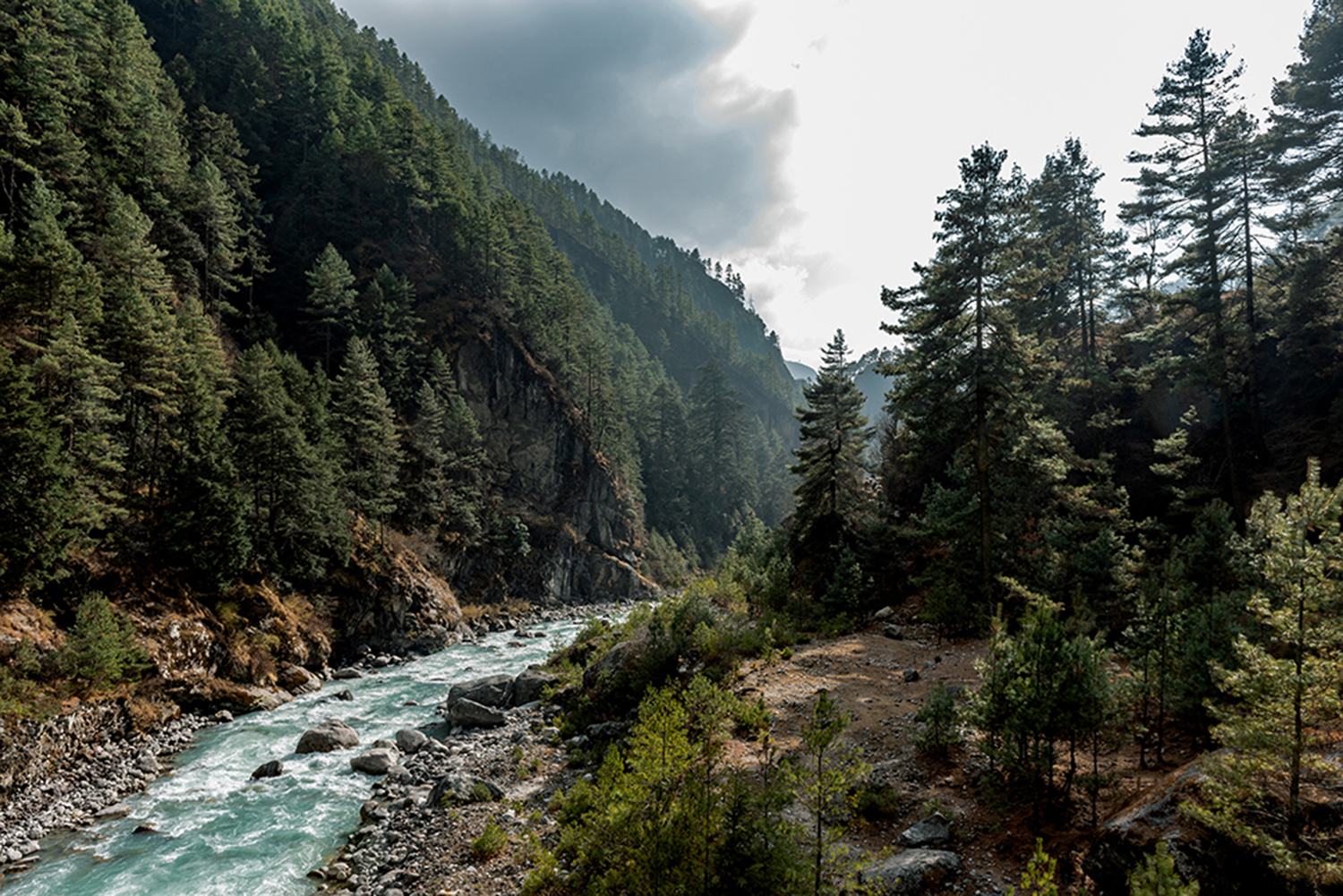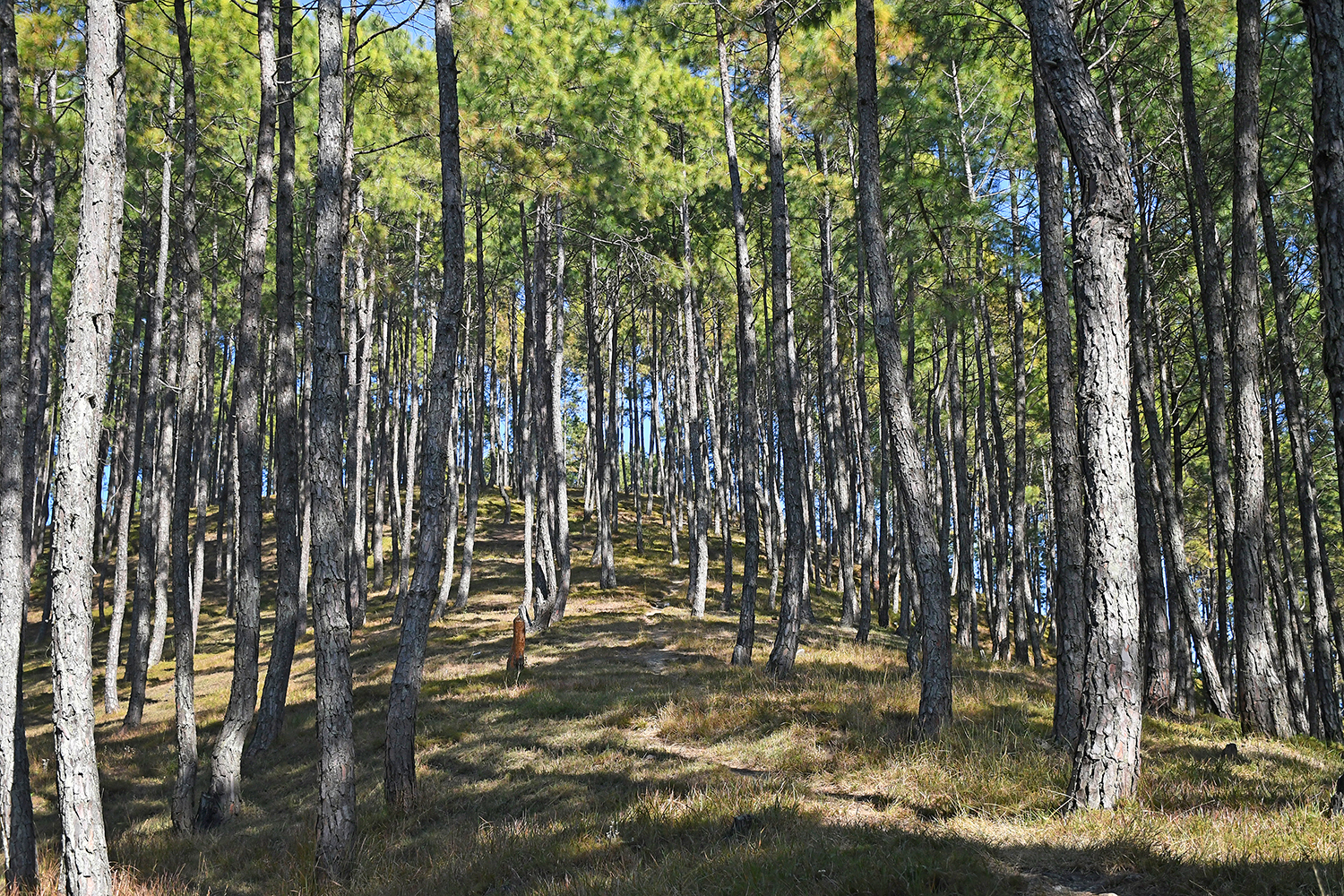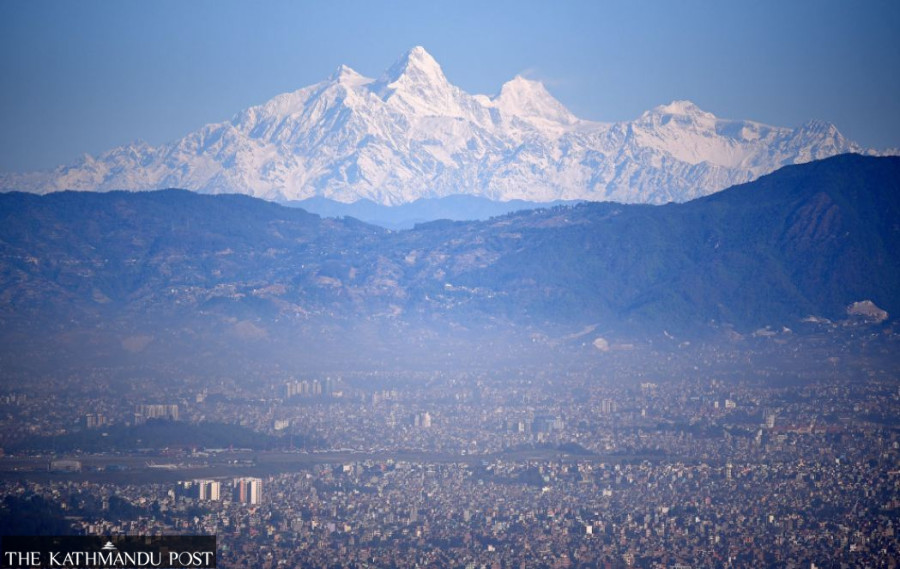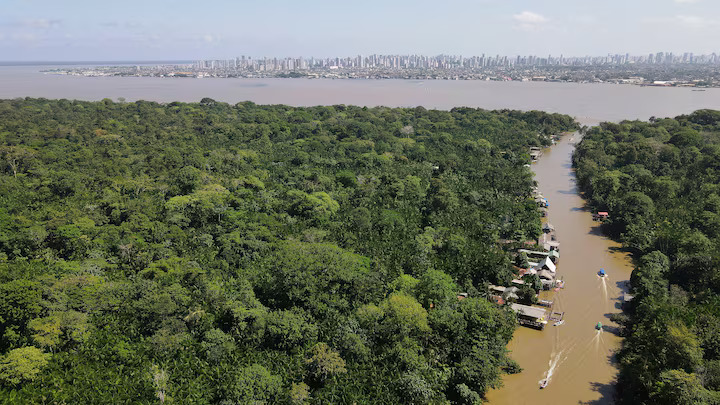Climate & Environment
We have too many pines and it’s not a good thing
Pine trees might have helped repopulate the country’s barren mid-hills but they could also have led to springs drying up and reduced vegetational diversity.
Tsering Ngodup Lama
Three decades ago, the hills behind Nurpu Sherpa’s house were barren and ugly. Today, they are lush green with pine trees—a result of a massive tree plantation drive in 1991 that began on the hills of Anthali Village, as well as the barren mountainside around the nearby villages.
“My grandfather and father were among the many locals from the villages who planted the pine trees,” said Sherpa. “The hills look much more beautiful today than they did when they were barren.”
But as the pine trees started to grow taller, the villagers began to notice something unexpected.
“Plants like chutra, banmara and titepati, which grew in abundance in the hills, started dying and disappearing from the forests. Even grass on the forest floor started dying,” said Sherpa. For villagers, this was a big problem, as the plants and grass provided fodder for the livestock that many in the villages reared.
The changes weren’t just limited to inside the forests. For decades, a network of 10 springs located in the villages had ensured that villagers had plenty of water to drink, bathe, and feed their livestock. The springs were also an important source of water for birds and wild animals.
“A few years into the pine plantation, we started noticing a depletion in water flow in all 10 springs. By 2010, eight of the springs had completely dried up; the remaining two disappeared after the 2015 earthquakes,” said Sherpa. “Now the water is not even enough for human use, let alone livestock and wild animals. We have never had to face such levels of water scarcity.”
For many years, the villagers remained unaware of what was behind the changes in the village’s natural ecosystem.
“Then we learned from government forest officials that pine trees deplete groundwater levels and inhibit the growth of other vegetation. Everything that was happening in our villages started to make sense,” said Sherpa. “It is these trees that are making our lives so difficult.”
The government didn’t just plant pine trees around the barren hills of Anthali, Baldung, and Dhanpal, in Sindhupalchok District; it did the same across the country. Infact, pine was the most abundant species the government planted in the mid-hills when it started its nation-wide afforestation drive in the 80s. But as these pine trees began to mature, their environmental impacts began to unravel.
Multiple reports from across the world have documented the manifold impacts of pine trees, including reduced vegetational diversity in forests and the drying up of water sources. Despite the fact that pine has become the predominant species in the mid-hills after the government’s afforestation drive, there have been few national studies regarding the consequences of these trees on the environment and on human settlements.
Why pine?

The government’s drive to plant trees in the mid-hills began in the 80s and continued well into the mid-2000s. But its roots date back to 1957, when the Private Forests Nationalisation Act was introduced. Before the Act came into effect, forested lands across the country were under individual and communal ownership, but the new law turned all forested lands in the country into public property.
“Rampant deforestation began when people learned that the government was planning to introduce the Private Forests Nationalisation Act. Many private owners, worried that they might have to hand over the land, started clearing forests,” said Ananta Bhandari, forest lead at WWF Nepal.
The Act also restricted people’s access to forest resources, which many depended upon for firewood, fodder for livestock and building materials.
“It was in the interests of the people to protect forests and ensure that the forests’ resources were used sustainably, but when the Act restricted access to the forests, people no longer felt the need to protect them. Illegal deforestation became rampant,” he said.
Even though the Act was introduced to prevent deforestation, it ended up facilitating the cutting down of trees, leading to unintended consequences, say both locals and experts.
Deforestation in the country became so rampant that by the 70s, Nepal’s forest coverage was decreasing by at least 1.7 percent annually, say experts. To address this, the government, in 1976, formulated the National Forestry Plan.
“The new policy made it the responsibility of the local panchayats to look after forests, laying the foundation for today’s community forests,” said Bhandari. “And in the 80s, in an effort to undo the decades of deforestation that had left vast tracts of forest lands barren, the government started a country-wide afforestation drive, and pine was chosen as the species to plant in the mid-hills.”
The choice of pine stems from many years of joint collaboration between the governments of Nepal and Australia, named The Nepal-Australia Forestry Project.
More than a decade before the afforestation drive began, the governments of Nepal and Australia had already started collaborating to identify which species of trees would be ideal to grow in the country’s mid-hills.
“The project, which started in the mid-60s, planted different species of broadleaf trees, fodder trees, pine trees, and eucalyptus trees to identify the best species to grow in the country’s mid-hills,” said Shambhu Prasad Dangal, country representative for RECOFTC (The Center for People and Forests) Nepal. “The study found that the ideal tree species was pine, as there were already native pine species in the mid-hills.”
Three of the most common pines that were used for plantation were Pinus roxburghii (khote salla), Pinus wallichiana (gobre salla), and Pinus patula (patle/patula salla).
“The country's objective was reforestation and to increase the forest coverage as quickly as possible. Pine made sense because it is a fast-growing species,” said Anustha Shrestha, researcher at the Institute for Social and Environmental Transition-Nepal. “Also, the soil quality of the barren mid-hills was poor, and pine doesn’t require fertile soil to grow. Once planted, pine doesn’t need much tending either. All these inherent characteristics made them the right trees to fulfill the country’s forest objective.”
In 1999, the country’s forest cover stood at 39.6 percent and by 2016, it had increased to 44.7 percent. The mid-hills, where pine is one of the most common species, is the greenest region in the country, with 37.8 percent of its land covered in forest.
But a few years into plantation, their negative impacts began to emerge.
The consequences of planting pines
.jpg)
In 2010, when Shrestha travelled to Gosainkunda Community Forest, a pine forest in Dhulikhel, to conduct a soil test, the villagers told her that the water level in the springs had started decreasing after the pine trees were planted. In a piece Shrestha wrote for the Post in 2016, she mentions that a study conducted in the Gosainkunda forest to measure water usage revealed that an average pine tree consumes an average of 13.5 litres of water daily. Bigger pines drain up to 80 litres per day.
“Some fifty years ago, Gosainkunda community forest had just shrubs and grass,” said 81-year-old Hari Bahadur Bhujel, a resident of Budol Village, which lies in the foothills of the forest. “Residents of nearby villages brought their livestock to graze in these hills. These hills also had around four natural springs, where our livestock used to drink and bathe. But once pine trees were planted here some 30 years ago, water sources started drying up. Now there’s not even a single source remaining.”
Located inside the Gosainkunda Forest is its namesake temple, which once housed two ponds where pilgrims would take baths.
“But the ponds are now empty. Elders from nearby Karki Gaun tell me there used to be around a dozen seasonal springs and a few perennial springs in these hills. But all of them have dried now,” said Dibya Mani Adhikari, headmaster of the Naimisharanya Sanskrit Gurukul, which is located near the temple. “The whole village is reeling under a water shortage.”
Dangal from RECOFTC echoes Adhikari, reporting numerous similar experiences from across the mid-hills.
“There have been multiple incidents where people told me how water sources started drying once pine trees were planted. But the truth is, we don’t have scientific evidence to back those claims,” he said.
Although a correlation can be established between the amount of water pine trees require and the drying up of springs, there is no large-scale study that irrefutably shows that pine is behind the reduction in water levels.
“There are some places in the mid-hills where there are thick pine forests but the villagers haven’t seen any reduction in water flow. If pine trees are the sole reason behind water depletion, these places should also see a drop in water levels,” said Rajendra KC, joint secretary at the Ministry of Forests and Environment’s Forest and Watershed Division.
According to KC, there are many other factors that are contributing to the depletion in water levels, with rampant road building across the hills being a prime reason.
“When you carve hills to build roads and other building activities, there are high chances of disrupting the natural flow of underground water channels,” he said. “It’s important for people to understand that before putting all the blame on pine trees for water scarcity.”
But reports of pine trees causing water level to drop are not limited in Nepal. Similar reports continue to be reported from countries across the world. According to an article published by Edith Cowan University in Perth, Australia, swathes of the Perth Banksia Woodlands were cleared and planted with pine trees to cater to the growing demand for timber. As the trees were cleared, the water level in the nearby Gnangara groundwater system rose. But as the pine trees grew, the water level started depleting. The university found that the pine trees were consuming more water than the trees they replaced. Fearing Perth would run out of water, the state government started clearing the pine plantation.
“Apart from being very water thirsty, pine trees also have very fibrous roots. This helps pine extract water collected deep within the soil, water that would have otherwise collected in aquifers,” said Dangal.
The fact that pine trees are coniferous evergreens, many experts say, could also contribute to the stress on aquifers, as the trees require water throughout the year. That is not the case with many broadleaf deciduous trees, which shed their leaves during the winter season, lessening the trees’ water intake.
The suspected impacts of pine trees are not just limited to water intake. According to WWF’s Bhandari, pine trees shed pine needles, which take longer to decompose than leaves from broadleaf trees. The needles end up carpeting the forest floor, and when it rains, the needles create a barrier that stops rainwater from percolating into the ground and reaching the aquifers.
The needles not only restrict water movement, but also impede grass from growing.
“This is the reason why we don’t often see much grass growing in pine forests,” said Shrestha. “The needles are acidic and change the pH content of the soil, hindering the growth of other trees and plants. What this does is create a pine monoculture in the forest, reducing the forests’ biodiversity, which is crucial for any natural forest ecosystem.”
Pine needles are also inedible to both livestock and many wild animals, which is leading to a dual problem. For wild herbivores, pine forests with limited vegetational diversity create food scarcity. This, experts say, could be one of the reasons for wild animals raiding agricultural fields.
“With no grass and plants growing, even our livestock don’t use pine forests,” said Sherpa, the local from Anthali village in Sindhupalchok. “So except for timber, pine has no use for us farmers.”
Reducing our pine dependency
.JPG)
“In a country like Nepal where people are still very dependent on forests, it’s very important to first understand what we want from our forests,” said Dangal. “If it’s just greenery and timber, then pine makes sense. But if you depend on forests for fodder and fuel, then we have to diversify forest vegetation so that the needs of the people are met.”
A lot of the negative impacts of pine trees, say experts, could have been avoided or minimised had the country focused on forest management measures alongside aggressive tree plantation.
“While the country did a great job in successfully conducting large-scale pine plantation, we failed to effectively manage our planted forests. Silvicultural techniques like thinning and tending to the pine forests after a certain period of time would have helped a lot,” said Bhandari.
The problem with pine trees is not something that has gone unnoticed by the government. The Nepal government, in its Environment Protection Rules 1997, came up with provisions to restrict the environmental impact of forest monoculture. The Act states that plantation of indigenous species of plants in a single block of 50 to 100 hectares of land in the Tarai and 25 to 50 hectares in the hills, and imported species on a single block of 10 to 50 hectares in the Tarai and 5 to 25 hectares in the hills, will only be allowed after conducting initial environmental examination.
The forest department, according to Joint Secretary of Forest and Watershed Rajendra KC, is also conducting a trial in a pine forest in Kavre by planting Schima wallichii (chilaune) and chestnut (katus) trees to see what kinds of species can best survive in pine forests.
But in the forests behind Nurpu Sherpa’s house, there is still nothing apart from pine trees.
“People from my village only had to walk five minutes to get grass and fodder for livestock. Now, they have to walk at least half an hour,” he said. “The water shortage has made things so challenging that many families have stopped rearing livestock or have reduced the number of animals. Had we known then what planting pine trees would lead to, the village elders would never have done it.”
***
What do you think?
Dear reader, we’d like to hear from you. We regularly publish letters to the editor on contemporary issues or direct responses to something the Post has recently published. Please send your letters to [email protected] with "Letter to the Editor" in the subject line. Please include your name, location, and a contact address so one of our editors can reach out to you.




 16.12°C Kathmandu
16.12°C Kathmandu





